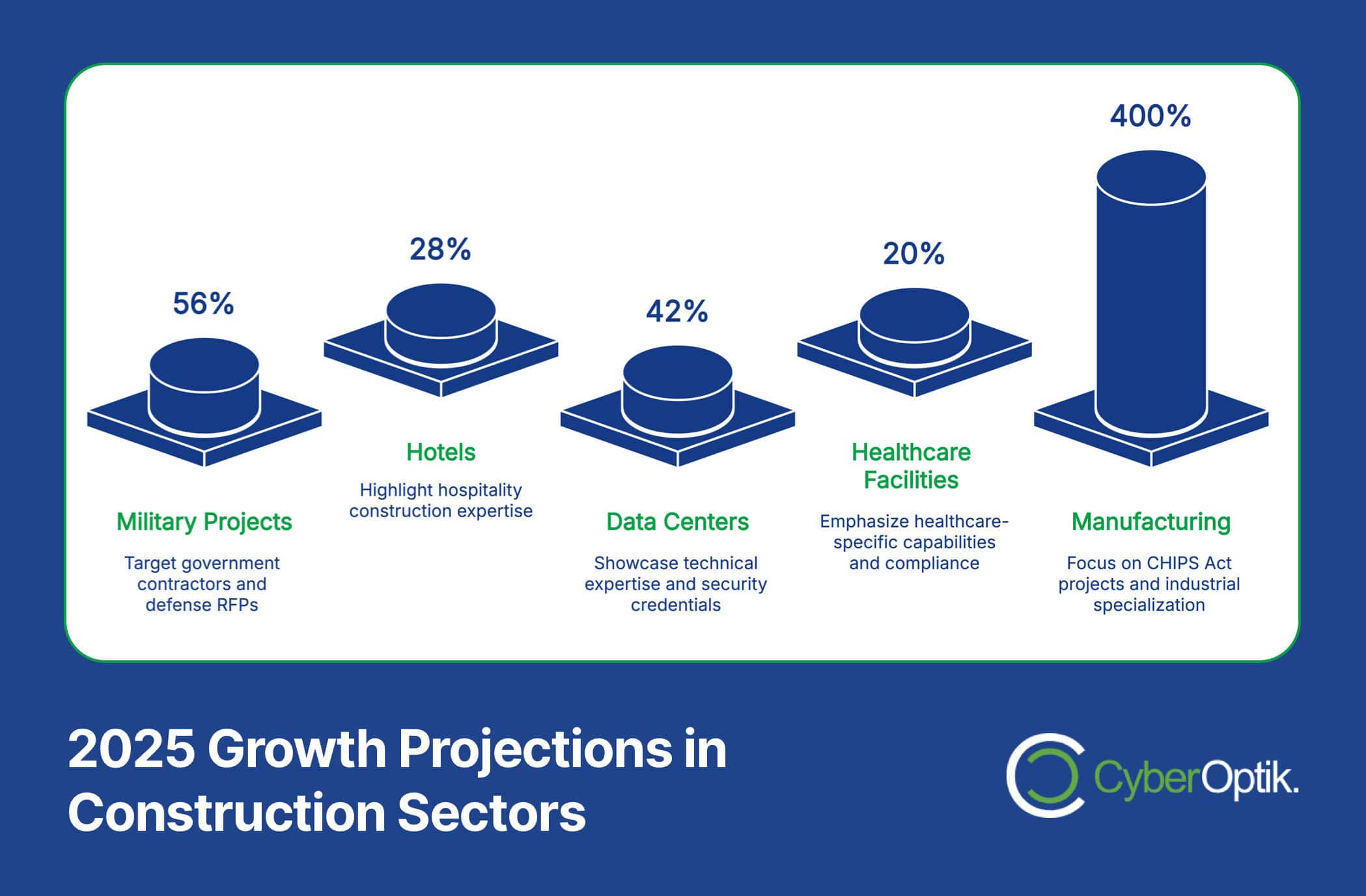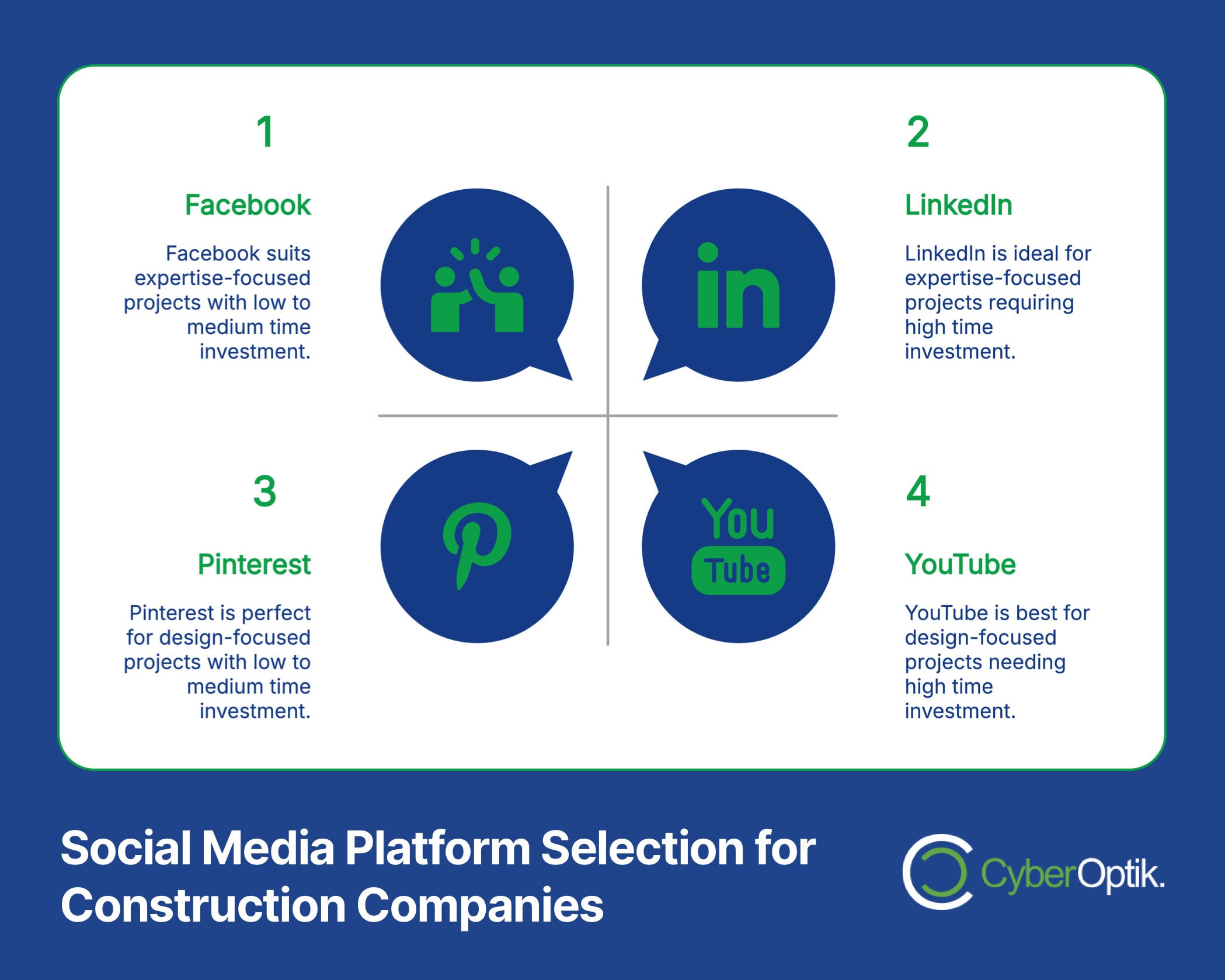Construction companies face unique marketing challenges in today’s competitive landscape. While the industry continues to grow, standing out from competitors requires more than quality workmanship and word-of-mouth referrals. We’ve seen firsthand how many construction businesses struggle to attract consistent leads despite delivering excellent work. The digital marketplace has transformed how clients find and evaluate construction services, creating both challenges and opportunities for forward-thinking companies.
As the construction sector evolves, so must your marketing approach. With U.S. construction spending crossing $2 trillion in the first half of 2024, the opportunity for growth is substantial for companies with effective marketing strategies. (Source: Deloitte)
In this comprehensive guide, we’ll explore the most effective marketing strategies specifically designed for construction companies. From digital fundamentals to advanced lead generation techniques, these approaches will help you build a stronger market presence and drive sustainable business growth.
Understanding the Construction Market Industry

Before diving into specific marketing tactics, it’s essential to understand the current construction landscape and where opportunities exist. The construction industry contributes significantly to the economy, representing 4% of U.S. GDP in 2022 and employing 8.3 million workers with 382,000 monthly job openings as of July 2024. (Source: Upmetrics)
Looking ahead to 2025, several economic factors will influence the construction market. GDP growth is forecasted at 2.5% for 2025, while Federal Reserve rates are expected to decline to 2.75% by late 2025, potentially stimulating more construction activity. (Source: Construction Business Owner)
Construction companies should align their marketing efforts with sectors showing the strongest growth potential. Not all segments of the construction industry are experiencing equal growth, and focusing your marketing on high-potential sectors can yield better results.
| Construction Sector | Growth Projection | Marketing Opportunity |
|---|---|---|
| Military Projects | 56% spending increase in 2025 | Target government contractors and defense-related RFPs |
| Hotels | 28% projected growth | Highlight hospitality construction expertise |
| Data Centers | Net optimism: 42% | Showcase technical expertise and security credentials |
| Healthcare Facilities | Moderate growth | Emphasize healthcare-specific capabilities and compliance |
| Manufacturing | $400B in federal investments | Focus on CHIPS Act opportunities and industrial specialization |
This table illustrates where the strongest growth is happening in the construction industry, with military projects anticipating a 56% spending increase and hotels projecting 28% growth in 2025. (Source: ConstructConnect)
Alongside these opportunities, construction companies face several marketing challenges that require strategic solutions:
- Intense competition – Local markets often have many contractors competing for the same projects
- Long sales cycles – Construction decisions involve multiple stakeholders and extended timelines
- Rising client expectations – Clients now expect comprehensive digital information before making contact
- Difficulty standing out – Communicating your unique value proposition effectively
- Cost fluctuations – Material costs are expected to rise 3-6% in 2025, affecting bidding and margins
The last point is particularly significant as construction companies develop their marketing and pricing strategies, with material costs projected to increase 3-6% in 2025 according to industry forecasts. (Source: IdealRev)
Essential Digital Marketing Fundamentals for Construction Companies
With market understanding established, let’s explore the foundational digital marketing elements every construction company needs. These core strategies work together to create visibility, generate leads, and establish credibility in your market.
Developing a Construction-Focused Website
Your website serves as the foundation of all your marketing efforts. For construction companies, a professional website isn’t just a digital brochure—it’s a lead generation tool that showcases your work and builds credibility.
We recommend focusing on these essential elements for a high-converting construction website:
- Portfolio showcase – High-quality images and videos of completed projects
- Service specialization pages – Detailed information about your specific offerings
- Client testimonials – Authentic feedback from satisfied customers
- Clear contact options – Multiple ways to request quotes or information
- Mobile optimization – A seamless experience on phones and tablets
Beyond these basics, construction websites should prioritize fast loading speeds. This is especially important as 82% of firms cite ongoing supply chain disruptions as a persistent issue, making potential clients more likely to research multiple contractors before making decisions. (Source: Bitner Henry)
Search Engine Optimization for Contractors
SEO helps construction companies appear in search results when potential clients look for services in their area. Unlike industries where national visibility matters, construction SEO should focus primarily on local visibility and industry-specific keywords.
Key components of an effective construction company SEO strategy include:
| SEO Element | Implementation Strategy | Business Impact |
|---|---|---|
| Local keyword targeting | Optimize for "[service] in [city]" phrases | Appears in relevant local searches |
| Google Business Profile | Complete profile with services, photos, and reviews | Appears in Google Maps and local pack results |
| Service-specific content | Create dedicated pages for each service offering | Ranks for specific service searches |
| NAP consistency | Name, address, phone consistent across web | Improves local ranking signals |
| Industry backlinks | Earn links from suppliers, associations, clients | Builds domain authority and credibility |
The table above outlines a comprehensive approach to construction SEO that combines on-site optimization with local search strategy. For most construction companies, local SEO efforts deliver the fastest return on investment compared to broader optimization strategies.
PPC Advertising for Immediate Visibility
While SEO builds long-term visibility, pay-per-click (PPC) advertising offers immediate placement for your services. Construction companies can benefit from targeted ads that appear when potential clients search for specific services.
Effective PPC for construction companies requires:
First, use tight geographic targeting to show ads only in your service area. Second, create service-specific ad groups with relevant keywords. Third, develop custom landing pages that match each service advertised. Fourth, implement call extensions to allow direct phone contact. Finally, focus bidding strategies on lead generation rather than just clicks.
We’ve found that construction companies that implement well-structured PPC campaigns alongside organic SEO efforts see more consistent lead flow, especially when entering new markets or promoting specialized services.
Content Marketing That Demonstrates Expertise
Content marketing helps establish your construction company as an authority while addressing potential clients’ questions. This approach has become increasingly important as data suggests construction robotics and automation technologies are projected to reach $3.81 billion by 2032, creating both challenges and opportunities for companies to demonstrate their modern expertise. (Source: Upmetrics)
Valuable content types for construction companies include:
Project spotlights that showcase your best work serve several purposes. Educational articles about construction processes help potential clients understand your methods. Comparison guides for materials demonstrate your expertise and transparency. Maintenance tips provide value even before someone becomes a client. Finally, industry trend analysis positions you as forward-thinking and knowledgeable.
Building a Strong Online Presence for Your Construction Business
Beyond the fundamentals, construction companies need strategies to build a compelling online presence that reflects their real-world expertise and quality.
Creating an Impressive Project Portfolio
Your completed projects represent your best marketing assets. A well-documented portfolio provides visual proof of your capabilities and craftsmanship that written claims simply cannot match.
For maximum impact with your construction portfolio:
Invest in professional photography that properly showcases your work quality. Create detailed project case studies explaining challenges and solutions. Organize projects by type to help prospects find relevant examples. Include key metrics like project timeline and scale where appropriate. Finally, feature authentic client testimonials alongside the visual evidence.
When developing your portfolio, focus on quality over quantity. Five well-documented projects with excellent photography and complete details create a stronger impression than twenty projects with minimal information and poor-quality images.
Optimizing Local Presence and Google Business Profile
For construction companies, local visibility often determines business success. Your Google Business Profile (GBP) serves as a powerful tool for appearing in local searches and on Google Maps.
| Local Optimization Element | Implementation Strategy | Impact on Lead Generation |
|---|---|---|
| Google Business Profile | Complete all sections with accurate information | Appears in local "map pack" searches |
| Location-based content | Create area-specific service pages | Ranks for "[service] in [location]" searches |
| Review generation | Actively request and respond to reviews | Builds credibility and improves rankings |
| Local citations | Consistent NAP on directories and associations | Strengthens local ranking signals |
| Local link building | Partnerships with local businesses and media | Builds local relevance and authority |
This local optimization strategy becomes even more important when considering public construction projects. Data centers, water/sewer projects, and transportation infrastructure show high optimism (35% and 29% net optimism respectively), making visibility to public sector decision-makers crucial. (Source: AGC)
Online Reputation Management
In construction, trust is everything. Online reviews significantly influence hiring decisions, with potential clients often eliminating companies with poor ratings before making contact.
A strategic approach to reputation management includes:
First, implement a systematic process for requesting reviews after project completion. Second, make reviewing easy by providing direct links to your preferred platforms. Third, respond professionally to every review—positive or negative. Fourth, address legitimate concerns with action rather than defensiveness. Finally, highlight positive reviews across your marketing materials.
Reputation management becomes particularly important when considering that liability concerns are rising, with “nuclear verdicts” (liability lawsuits exceeding $10 million) becoming more common in the construction industry. (Source: Bitner Henry)
Targeted Lead Generation Strategies for Contractors
With foundational elements in place, construction companies can implement specialized lead generation strategies designed to attract qualified prospects.
Service-Specific Landing Pages
Generic web pages rarely convert well for construction services. Create dedicated landing pages for each primary service, targeting specific client needs and pain points.
Effective construction landing pages include these elements:
Start with a clear headline stating the specific service offered. Include relevant project examples with high-quality images. Address common questions and concerns about this particular service. Showcase service-specific credentials, licenses, and expertise. Finish with a strong call-to-action offering consultations or estimates.
The effectiveness of service-specific pages increases when paired with matching ad campaigns or targeted email marketing efforts. With housing starts projected to rise 6.2% in 2025 after declines in 2023-2024, residential construction companies should particularly focus on creating dedicated landing pages for these services. (Source: Construction Business Owner)
Lead Capture and Qualification Systems
Not all leads are equal in construction. Implementing systems to capture, qualify, and nurture leads improves conversion rates and sales efficiency.
| Lead System Component | Implementation Approach | Business Benefit |
|---|---|---|
| Multi-step forms | Progressive information gathering | Higher completion rates, better qualification |
| Live chat | Immediate engagement option | Captures leads who prefer conversation |
| Automated follow-up | Email sequences based on inquiry type | Prevents leads from going cold |
| CRM integration | Centralized lead management | Improved tracking and conversion |
| Lead scoring | Prioritize based on project details | Focus resources on highest potential leads |
This systematic approach to lead management becomes increasingly important when considering the challenging labor market construction companies face. With labor costs increasing 4.3% in 2024 due to skilled worker shortages, maximizing the efficiency of your sales team through better lead qualification is essential. (Source: Bitner Henry)
Email Marketing for Project Updates and Nurturing
Email marketing remains one of the most cost-effective channels for nurturing leads through lengthy construction sales cycles. Regular, value-focused emails keep your company top-of-mind during extended decision processes.
Construction-specific email content should include:
Project spotlights featuring recent completions demonstrate your capabilities in action. Educational content about materials or processes positions you as an expert resource. Seasonal service reminders help generate additional work from past clients. Industry news and updates show you stay current with trends. Finally, exclusive offers or consultations create urgency for fence-sitting prospects.
For construction companies, email marketing works best when segmented by project type (residential vs. commercial) and by sales funnel stage (awareness, consideration, decision). This targeted approach ensures recipients receive relevant information based on their specific needs and interests.
Leveraging Social Media for Construction Company Marketing
Social media offers construction companies powerful platforms to showcase their work visually and build community engagement.

Choosing the Right Platforms
Not all social media platforms yield equal results for construction companies. Focus efforts on platforms that support visual content and reach your target audience effectively.
| Social Platform | Best Content Types | Ideal For | Time Investment |
|---|---|---|---|
| Project photos, time-lapse videos | Residential construction, design-focused projects | Medium | |
| Project stories, community involvement | General audience, local reputation building | Medium | |
| Case studies, industry insights | Commercial projects, B2B networking | Medium-High | |
| YouTube | Project walkthroughs, educational videos | Showcasing complex projects, expertise | High |
| Design inspiration, before/after transformations | Renovation projects, design-focused work | Low-Medium |
The most effective approach is to master one or two platforms rather than maintaining a mediocre presence across all of them. For most construction companies, a combination of Instagram (for visual project showcasing) and either LinkedIn (for B2B) or Facebook (for residential) provides the best return on time invested.
Content Strategies for Maximum Impact
Social media success depends on consistent, engaging content that showcases your expertise and builds your brand. For construction companies, visual content performs particularly well.
High-performing construction social content includes:
Project progression showcases the transformation from start to completion. Behind-the-scenes content reveals your expertise and attention to detail. Team spotlights humanize your company and highlight credentials. Educational content demonstrates knowledge while providing value. Client testimonials and stories build trust through social proof.
When creating social content, focus on quality over quantity. One excellent post weekly performs better than daily low-quality updates. This becomes particularly important when adapting to emerging technologies like AI integration and predictive analytics, which are increasingly streamlining construction workflows. (Source: Cemex Ventures)
Social Advertising for Targeted Reach
Organic reach has limitations. Strategic paid social media advertising allows precise targeting of potential clients based on demographics, interests, and behaviors.
For construction companies, effective social ad approaches include:
Showcase visual project content through carousel and video ads that highlight your work. Use lead generation campaigns with pre-filled forms to simplify inquiries. Implement retargeting to stay visible to previous website visitors. Create lookalike audiences based on past client characteristics. Finally, use geographic targeting to focus only on your service area.
The investment in social media advertising becomes most effective when integrated with your broader marketing strategy and tied to specific goals like lead generation, brand awareness, or promoting particular services.
Measuring and Optimizing Your Construction Marketing ROI
Effective marketing requires consistent measurement and optimization. For construction companies, tracking the right metrics ensures marketing investments generate profitable returns.
Construction-Specific KPIs
Generic marketing metrics don’t always translate well to construction. Focus on industry-specific key performance indicators that directly relate to revenue and growth.
| Key Performance Indicator | How to Calculate | Target Benchmark |
|---|---|---|
| Cost Per Lead (CPL) | Marketing spend ÷ Number of leads | $75-150 (varies by service type) |
| Lead-to-Client Conversion Rate | (New clients ÷ Leads) × 100 | 10-15% for qualified leads |
| Marketing-Influenced Revenue | Project value from marketing sources | 3-5× marketing investment |
| Client Acquisition Cost (CAC) | Marketing spend ÷ New clients acquired | 15-20% of first project value |
| Lifetime Value to CAC Ratio | Client lifetime value ÷ CAC | 3:1 minimum, 5:1 ideal |
By tracking these construction-specific metrics, you can make data-driven decisions about which marketing channels deserve more investment and which need optimization or reconsideration.
Analytics and Reporting Tools
Proper measurement requires the right tools. Implement analytics systems that track meaningful metrics for construction marketing.
Essential tracking systems for construction companies include:
First, use Google Analytics to monitor website performance and user behavior. Second, implement call tracking to attribute phone inquiries to marketing sources. Third, utilize a CRM system to track leads through your sales pipeline. Fourth, set up conversion tracking for specific goals like form submissions. Finally, use project management software that connects marketing leads to completed projects.
With these systems in place, construction companies can accurately attribute new projects to specific marketing efforts and calculate true return on investment for each channel and campaign.
Continuous Improvement Process
Marketing effectiveness improves through consistent analysis and optimization. Implement regular review processes to refine strategies based on performance data.
We recommend quarterly marketing reviews that examine:
Start by analyzing lead sources to identify which channels generate the most opportunities. Next, evaluate conversion rates by marketing channel to find where quality may be lacking. Then, assess cost per lead and client acquisition costs against benchmarks. Also important is connecting marketing efforts to actual project types and profitability. Finally, look for seasonal patterns to adjust campaigns accordingly.
This data-driven approach becomes especially valuable when considering the increasing impact of extreme weather events, with 27 U.S. billion-dollar weather disasters in 2024 affecting construction projects. Marketing flexibility based on seasonal and regional factors can help mitigate these challenges. (Source: Bitner Henry)
Future-Proofing Your Construction Marketing Strategy
The construction marketing landscape continues to evolve. Forward-thinking companies should prepare for upcoming trends to maintain competitive advantage.
Embracing Technology Advancements
Emerging technologies are reshaping how construction companies market their services and engage with potential clients.
Technologies to monitor and potentially adopt include:
Virtual reality allows clients to experience spaces before construction begins. Drone footage provides compelling aerial views of projects and progress. AI tools enable more sophisticated lead qualification and personalization. Voice search optimization becomes crucial as more clients use digital assistants. And augmented reality applications help clients visualize completed projects in their existing spaces.
The construction companies that thrive will be those that strategically adopt relevant technologies rather than chasing every new trend. With the global construction revenue reaching $15.46 trillion in 2023, the industry has significant resources to invest in technological advancement. (Source: Upmetrics)
Sustainability Marketing for Competitive Advantage
Environmental consciousness is increasingly important to clients. Highlighting sustainable practices can differentiate your construction company in competitive bidding situations.
Effective sustainability marketing includes:
First, showcase any green building certifications your projects have achieved. Second, document and share your sustainable material usage in projects. Third, highlight energy efficiency improvements in completed buildings. Fourth, demonstrate waste reduction practices that minimize environmental impact. Finally, connect sustainability efforts to cost savings and long-term value for clients.
This approach aligns perfectly with the growing trend toward bio-based and recycled materials in construction, which are gaining significant traction in the industry. (Source: Cemex Ventures)
Building Long-Term Client Relationships
The most valuable marketing often comes from repeat business and referrals. Digital channels offer new ways to maintain relationships with past clients.
Consider implementing these relationship-building strategies:
Create automated maintenance reminders that provide value while keeping in touch. Develop an exclusive content program for past clients with industry insights. Implement referral incentive programs that reward clients for recommendations. Send project anniversary follow-ups to check satisfaction and suggest upgrades. And build a community through private groups where clients can connect and share experiences.
These approaches create ongoing engagement opportunities and position your company for additional projects when needs arise. With private office and retail construction expected to lag in coming years, nurturing existing client relationships becomes even more critical for maintaining steady business. (Source: AGC)
Building an Integrated Construction Marketing Approach
Effective marketing for construction companies requires a strategic, integrated approach that combines digital visibility, trust-building, and consistent lead generation. By implementing the strategies outlined in this guide—from SEO and content marketing to social media and reputation management—construction businesses can build a marketing foundation as solid as their physical projects.
The most successful construction companies integrate these marketing strategies into a cohesive plan that showcases their unique strengths while addressing client needs at every stage of the decision process. With consistent implementation and measurement, these approaches can drive sustainable growth even in competitive markets.
At CyberOptik, we specialize in helping construction companies develop and implement effective digital marketing strategies that generate qualified leads and build lasting market presence. Our experience with contractors across various specialties has shown that the right marketing approach not only increases lead volume but improves lead quality and conversion rates.
Ready to build a stronger marketing foundation for your construction company? Contact our team for a consultation on how we can help elevate your digital presence and drive your business growth.




